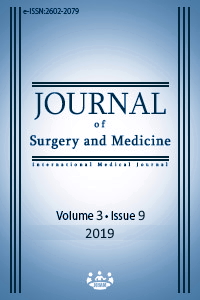Pattern of muscle involvement according to needle electromyography findings in clinically unaffected extremities of polio survivors with lower extremity weaknesses
Keywords:
Needle electromyography, Poliomyelitis, Subclinical involvementAbstract
Aim: Late neuromuscular deterioration may be seen in patients with a history of paralytic poliomyelitis. One of these problems is the development of a new weakness in clinically unaffected muscles. We aimed to determine needle electromyography (EMG) findings in these clinically unaffected limb muscles and to contribute to the physiotherapy strategies of poliomyelitis.
Methods: Patients with sequelae of poliomyelitis were included in this retrospective cohort study. Needle EMG findings of the patients were reviewed. If there were neurogenic needle EMG findings in the limb or muscle with no weakness, this muscle or limb was considered to be a subclinically affected muscle or limb.
Results: Eighteen patients were included in the study. Needle EMG findings of 190 muscles were analyzed. In the lower extremities, 18 (72%) of 25 clinically unaffected muscles had neurogenic needle EMG findings, and 14 (35%) of 40 upper extremity muscles had subclinical involvement. In the lower extremity muscles, this subclinical involvement was significantly higher than in the upper extremity muscles (P=0.004). In clinically unaffected upper and lower extremity muscles, the most prominent neurogenic needle EMG findings were in the deltoideus and vastus lateralis muscles, respectively (P=0.022 and P=0.028, respectively).
Conclusion: Subclinical involvement was more prominent in the lower extremity than in the upper extremity in polio survivors with weakness of lower extremity. The most prominent subclinical muscle involvement in the lower and upper extremities was the vastus lateralis and deltoideus muscles, respectively. We think that physical therapy strategies considering these findings will be beneficial for polio survivors.
Downloads
References
Agre JC, Rodriquez AA, Tafel JS. Late effects of polio: critical review of the literature on neuromuscular function. Arch Phys Med Rehabil. 1991;72:923-31.
Horstmann DM. Epidemiology of poliomyelitis and allied diseases – 1963. Yale J Biol Med. 1963;36:5-26.
Bodian D, Howe HA. The pathology of early arrested and nonparalytic poliomyelitis. Bull Johns Hopkins Hosp. 1941;69:135-47.
Luciano CA, Sivakumar K, Spector SA, Dalakas MC. Electrophysiologic and histologic studies in clinically unaffected muscles of patients with prior paralytic poliomyelitis. Muscle Nerve. 1996;19(11):1413-20.
McComas AJ, Quartly C, Griggs RC. Early and late losses of motor units after poliomyelitis. Brain. 1997;120:1415-21.
Bodian D. Histopathological basis of clinical findings in poliomyelitis. Am J Med. 1949;6:563-78.
Kidd D, Williams AJ, Howard RS. Poliomyelitis. Postgrad Med J. 1996;72(853):641-7
Lo JK, Robinson LR. Postpolio syndrome and late effects of poliomyelitis. Part 1. Pathogenesis, biomechanical considerations, diagnosis, and investigations. Muscle Nerve. 2018;58(6):751-9.
Stalberg E, Grimby G. Dynamic electromyography and muscle biopsy changes in a 4-year follow-up: study of patients with a history of polio. Muscle Nerve. 1981;4:524-8.
Kumar K, Kapahtia NK. The pattern of muscle involvement in poliomyelitis of upper limb. Int Orthop. 1986;10(1):11-5.
Sharrard WJ. The distribution of the permanent paralysis in the lower limb in poliomyelitis; a clinical and pathological study. J Bone Joint Surg Br. 1955;37(4):540-58.
Farbu E, Gilhus NE, Barnes MP, Borg K, Visser M, Driessen A, et al. EFNS guideline on diagnosis and management of post-polio syndrome. Report of an EFNS task force. European Journal of Neurology. 2006;13:795-801.
Chen S, Andary M, Buschbacher R, Del Toro D, Smith B, So Y, et al. Electrodiagnostic reference values for upper and lower limb nerve conduction studies in adult populations. Muscle Nerve. 2016;54(3):371-7.
Jubelt B, Cashman NR. Neurological manifestations of the post-polio syndrome. Crit Rev Neurobiol. 1987;3:199-200.
Ravits J, Hallett M, Baker M, Nilsson J, Dalakas MC. Clinical and electromyographic studies of postpoliomyelitis muscular atrophy. Muscle Nerve. 1990;13:667-74.
Şenol MG, Kaplan C, Ozdağ F, Saraçoğlu M. How long denervation take in poliomyelitis? Or is it a lifetime? Neurosci Rural Pract. 2018;8(4):511-5.
Downloads
- 1381 1968
Published
Issue
Section
How to Cite
License
Copyright (c) 2019 Halit Fidancı, İlker Öztürk, Ahmet Candan Köylüoğlu, Şencan Buturak, Zülfikar Arlıer
This work is licensed under a Creative Commons Attribution-NonCommercial-NoDerivatives 4.0 International License.
















